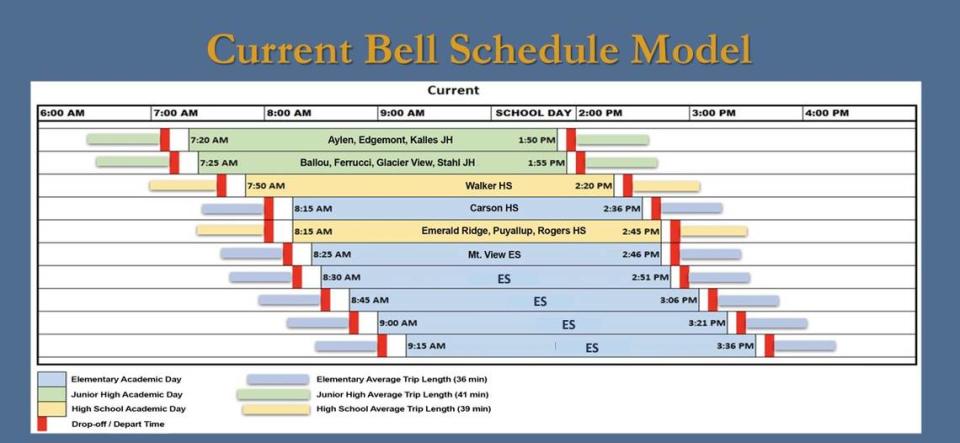This local school district may change its bell schedules due to a lack of bus drivers
There’s a chance students and parents in the Puyallup School District might have to adjust their sleep schedule this fall.
The school board asked a committee called the Bell Time Task Force to recommend new bus routes for the 2023-24 school year, to address the shortage of bus drivers many schools are still experiencing.
“We’ve determined that we are not using transportation resources efficiently,” school district spokesperson Sarah Gillispie said.
The task force is comprised of school staff, families and students. Vince Pecchia is leading the task force. He’s the school district’s assistant superintendent of operations and school support.
The task force presented three different bell time scenarios they thought were plausible to the school board on March 10.
The first reading of the task force’s recommendation is scheduled for March 20 during the school board meeting. April 5 is when the second reading is expected to happen, during which the board would adopt or reject it.
The school district’s current bell schedule has junior high schools start as early as 7:20 a.m. and end as late as 1:55 p.m. High schools start as early as 7:50 a.m. and end as late as 2:45 p.m. Elementary schools start as early as 8:25 a.m. and end as late as 3:36 p.m.

The first scenario is similar to the current schedule. However, all junior high schools and one group of elementary schools would start as early as 7:30 a.m. and end as late as 2 p.m. All high schools and another group of elementary schools would start as early as 8:15 a.m. and end as late as 2:45 p.m. The last group of elementary schools would begin as early as 9 a.m. and end as late as 3:21 p.m.
Compared to the current schedule, junior high school students would start between five to 10 minutes later. High school students would start at the same time or up to 25 minutes later. This scenario requires about 15 more buses and drivers, Pecchia said.

The second scenario is also similar to the current schedule. All junior high schools would begin as early as 7:30 a.m. and end as late as 2 p.m. All high schools would start as early as 8:15 a.m. and end as late as 2:45 p.m. All elementary schools would start as early as 8:50 a.m. and end as late as 3:51 p.m.
Pecchia said this scenario uses buses multiple times, which makes it more efficient.

The third scenario is different from the current schedule. All elementary schools would start as early as 7:40 a.m. and end as late as 2:51 p.m. All high schools would start as early as 8:30 a.m. and end as late as 3 p.m. All junior high schools would begin as early as 9:20 a.m. and end as late as 3:50 p.m.
One challenge with this scenario is junior high students’ ability to participate in athletics or advanced classes.

The task force discussed how each scenario could play out in the school district, Pecchia said. They considered the traffic that exists and school activities, as well as other factors that affect transportation.
The school district issued a survey in January, asking how a bell schedule change could impact families. The survey got over 3,300 responses. One of the biggest concerns is childcare — costs may increase if times need to be adjusted to accommodate a new bell schedule.
Brain research also came into play. Pecchia said during the March 10 school board meeting that the third scenario takes into account research from the Centers for Disease Control and Prevention regarding adolescents — they fall asleep later at night and sleep later in the morning.
“A combination of late bedtimes and early school start times results in most adolescents not getting enough sleep,” Pecchia said during the meeting.
The school district has 168 buses, 112 bus drivers and 106 routes as of March 1. Buses serve between 14,000 to 15,000 students per day.
Gillispie said transportation challenges continue. There’s been a delay in pickup and drop-off times, among other things. Students are getting to school and back home later than they’re supposed to. This results in inequitable access to student programs and a negative rider experience overall, she said.
The task force held its first meeting in September 2022, and the members have been meeting every month since then. Adjusting school bell times makes the school district use its transportation resources more efficiently, Gillispie said.
“When we’re efficient with our transportation resources, we can ensure that all students have access to all programs in the district,” Gillispie said. “That is one of the driving objectives of this work.”


